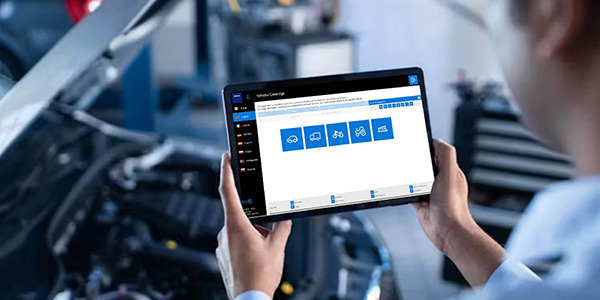This article was originally published in Brake & Front End.

Collisions with potholes, curbs and other vehicles are inevitable. While damage to body panels is easy to spot, damage to the suspension and the safety systems can be challenging to detect. If you have to deal with the mechanical side of collision repair, the game has changed over the past 20 years.
The first wave of changes took place with the design and material of car and truck suspensions. If you look at the best-selling vehicles from the past 20 years, more and more are coming with independent rear suspensions. Today, many automakers are engineering full-sized pickups with independent rear suspensions for consumers for the 2020 model year. Also, more suspensions are using sophisticated geometry and advanced materials like aluminum and composites.
The other revolution is the integration of sensors and actuators that work to keep a vehicle out of a collision.
ABS and stability control systems have become standard features on most of the vehicles sold during the past decade. New advanced driver-assistance systems (ADAS) are using the foundations of ABS to actively help drivers avoid collisions and conditions that are potentially dangerous.
These technologies are merging and changing how suspension and vehicles can be damaged in a collision and adding new dimensions to alignments.
Inspection
The first thing to do is a complete visual inspection. The key is to compare components from side-to-side. Also, pay attention to the material of the suspension components.
Stamped steel and cast iron can bend, and aluminum components are as strong or stronger than steel or cast iron. But what sets aluminum apart is how it fails. Most aluminum suspension components are extruded or forged and, in some cases, will be heat-treated. If a component has undergone extreme stress, the part will most likely crack and break instead of bend.
An aluminum component should never be welded or heated. The heat from welding can ruin the temper of a component and make it more brittle. Check the ride height of the vehicle. If the ride height is out of specification, it has implications for the suspension angle and the alignment of some ADAS sensors such as a camera.
Getting the Angles
Once the angles are captured, it is not enough to make sure the angles are in the green. To make sure there is no damage, look at the cross camber, cross caster and SAI, and never ignore the thrust angle.
Even with the toe adjusted and the steering wheel straight, a bent steering arm or strut rod can cause the SAI to be out of specification.
Steering Angle
If a vehicle has ABS and stability control, chances are it has a steering angle sensor somewhere on the steering column. As part of any post-collision alignment, the steering angle sensor needs to be inspected and calibrated with a scan tool.
The steering angle is a core piece of data that is used by almost every ADAS safety system today and in the future.
If the data from the steering angle sensor is not plausible or missing, it will deactivate almost every active safety system on a vehicle from backup camera lines to autonomous lane keeping.
Blind-Spot Sensing
Blind-spot monitoring on late-model vehicles is often the first exposure to ADAS a driver will have. Most systems use lights in the side mirrors to communicate to the driver, but some systems will shake the seat to alert the driver. Some drivers have mistaken the seat shaker as a mechanical problem with the suspension or drivetrain.
Most blind-spot systems have sensors located on each side of the rear bumper cover. The sensors use a low-energy radar to determine the presence of objects nearby. If the rear bumper cover has been removed, replaced or painted, the sensors need attention.
You may get a message indicating the system is not available in the instrument cluster. Typically, this warning is an indicator the driver needs to remove snow or dirt away from the sensor. If there is an issue with the sensors or module, it might generate codes that can be read with a scan tool.
Side object detection systems are not stand-alone systems. The blind-spot detection module communicates with multiple modules such as the radio/infotainment, body control and instrument cluster. Also, blind-spot detection uses data such as vehicle speed and steering angle to operate.
Some blind-spot systems require calibration with test fixtures and a scan tool. Always consult the service information. Some OEMs recommend calibration any time the bumper cover is removed.
Cameras Under Glass
Most higher-level, ADAS-equipped vehicles will have a camera mounted behind the windshield used for lane departure, automatic braking and even autonomous steering.
If the windshield was replaced as part of the repair, you need to inspect the operation of the camera with a scan tool and calibrate the camera with the correct procedures and tools. Even if the camera was not touched during the repair, it is always a good practice to check its operation and accuracy.
There are two ways for an ADAS system to be calibrated. One method involves using targets mounted to a fixture at precise distances from the sensors. The targets have patterns that the vehicle’s camera recognizes or that can reflect the beam. The recalibration process is initialized with a scan tool. The other method is a self-learn test drive that is also initiated with the help of a scan tool.
Looking Forward
More vehicles are using forward radar to detect other cars and objects.
Unfortunately, radar sensors and their mounting points are the first components to be taken out in a front-end collision.
Radar sensors need to be calibrated if they have been disturbed. This recommendation includes mechanical repairs that could alter the position of the radiator core support on some vehicles.
The most important thing to remember about repairing any vehicle that has been damaged by a collision with another vehicle or curb is that it still requires careful inspection and precision alignment at the core of the repair. Even if the mechanical specifications for the thrust angle and ride height are corrected, proper calibration of an ADAS system will not automatically happen.
Andrew Markel is an ASE-certified technician and former service writer, and he brings this practical knowledge to the Brake & Front End team as director of content.













